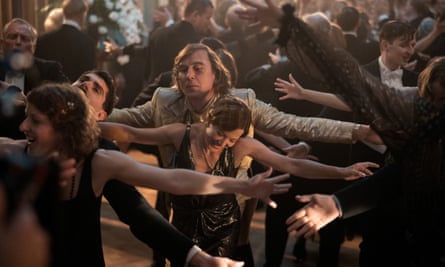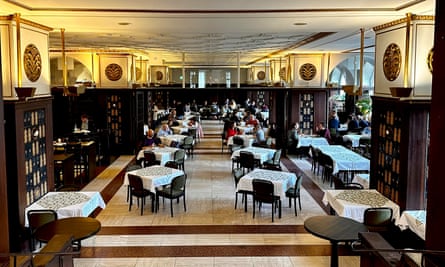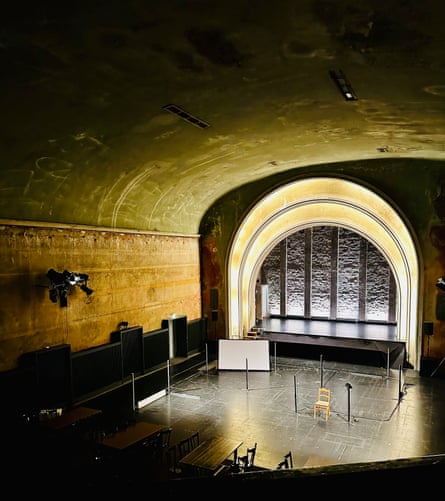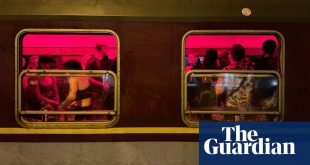A cold mist lingers on the River Spree as autumn tightens its grip around Berlin, beams of neon lights refracted in the thick air, the art deco logo of KaDeWe department store reflected on the damp ground. This city, with its loaded, complex history, provides the ideal backdrop for drama.
A drama such as Babylon Berlin, the detective noir television series set in the chaotic world of jazz-age Berlin. With season four starting on Friday on Sky Atlantic, I’d come to explore what echoes of the last era of the Weimar Republic linger in the city. The new series brings us to 1931, where sinister forces are not so much lurking in the shadows as thrusting themselves front and centre – a place where the people went on dancing as the world began to fall apart.

My base in Charlottenburg is the suitably atmospheric Henri Hotel. Housed in a 19th-century building, moments from the main shopping street of Kurfürstendamm, it feels like a step back in time. Parquet flooring, period furniture and low lighting add richness; I feel like an early 20th-century bohemian writer in my elegant room.
Babylon Berlin now has an affiliated tour (€29 as part of a group tour, private tours available on request), and I set out to meet fan, historian and extra from the show Arne Krasting at Immanuelkirche Pfarrsprengel Church in fashionable – but at the time completely impoverished – Prenzlauer Berg. The church supplies the backdrop for the opening scene of the first-ever episode, and from there, Arne takes me through the city, via the Red Town Hall in Alexanderplatz, which plays the part of the Red Castle in the show, and the Schöneberg town hall – with the balcony from which Kennedy made his “Ich bin ein Berliner” speech. This building supplies the interiors of the Red Castle, in reality now consigned to history; a heap of rubble after the second world war.

In the basement is the “Ratskeller” canteen – the setting for the smoky police canteen in the show. It’s open to the public, serving tasty and inexpensive traditional German food like meatballs and dumplings in a grand art deco setting.
The Weimar Republic – a democracy imposed on Germany from 1918 to 1933 as part of the Versailles treaty – is regarded as an incredibly innovative time for science, politics, culture and medicine. An entire generation – their understanding of the world upended by the horrors of the first world war – found new forms of expression to challenge and question the old world order. This ranged from the Dada art movement, via expressionist cinema, psychology, and then to Germany’s most famous contribution to the visual identity of the roaring 20s, Bauhaus. While the Berlin Bauhaus museum is currently closed for a major renovation, the temporary Bauhaus archive – situated in the listed Haus Hardenberg, built in the mid-50s but owing a heavy debt to the utilitarianism and experimentation of the initial school – offers a condensed guide to this movement through an immersive interactive exhibition. I stand in a dark space surrounded by moving images on giant screens, as a pad allows me to virtually select items from the collection by category, artist or even a colour wheel. It’s a suitably abstract experience.

The frenetic nature of Babylon Berlin would be nothing without the music and movement, and the enormous dance set-pieces electrify the screen whenever they appear. Of course, flappers – personified by Liv Lisa Fries’ character Lotte in the show – were a major feature of the “Golden Twenties”, and the dances developed from the Charleston in the early part of the republic to the lindy hop in the latter. I head east again to Prenzlauer Berg and to Swing Patrol dance class.
Dressed in jeans and shirt, I quickly conclude that my clothing choices are misguided, to say the least. Ten minutes into some basic Charleston moves, the sweat is pouring off me. Though there’s no sense of the era here – apart from the accompanying music – it’s lots of fun.
Quick-stepping to the other side of town, I arrive at Wintergarten – one of the big venues in Weimar Berlin. The original version of this legendary theatre, which played host to the likes of Josephine Baker and Claire Waldoff, was destroyed in the allied raids in 1944, but the rebuilt version is 30 years old this year. A 1920s variety revue is the order of the day, followed by an indulgent three-course meal in the authentically furnished art deco dining room. Immersed the Varieté and revue-filled sumptuous splendour of the theatre, it was almost like being at the original – we even have our own brand of impending political doom to return to once the show’s over.

The next morning, I have a private visit to Theater im Delphi, which, as a silent-film cinema, once played host to the likes of Marlene Dietrich and Fritz Lang, managed to survive both the second world war and the GDR, and is now a theatre performance space, doubling as the legendary flapper club Moka Efti in Babylon Berlin. The soaring archways, shabby-chic faded paintwork and mottled plastering seem to sum up the era perfectly – beautiful, decadent, damaged. There is a full programme of events so you can see the space yourself, but their Christmas performances of The Little Prince are something particularly special.
For my final night, I move to 25 Hours Hotel Berlin, not only a modern iteration of the fun and hedonism which the city has always promised, but sitting above a space which used to house The Gourmenia, a prominent art deco entertainment venue built shortly before the 1929 stock market crash. The crash was the death sentence for the republic, and in Babylon Berlin season four, we see it in the death throes.

Berlin has rarely stopped dancing, however. Well, maybe for five years or so in the 1940s. Today, the revellers who fill the hotel’s wonderful Monkey Bar overlooking the zoo, or queue for hours outside infamous techno mecca Berghain, are merely a continuation of a tradition which started long before the Weimar Republic, and will continue long after Berghain eventually closes its doors … this is after all, a city that loves to dance in the darkness.
The trip was provided by Visit Berlin. Babylon Berlin season four starts on Sky Atlantic on October 14, with all four seasons available on Now
 Top Naija News: Nigerian News, Breaking News Nigeria and World News Top Naija News is a daily news publication in Nigeria, delivering the latest breaking news in Nigeria and around the world.
Top Naija News: Nigerian News, Breaking News Nigeria and World News Top Naija News is a daily news publication in Nigeria, delivering the latest breaking news in Nigeria and around the world.



